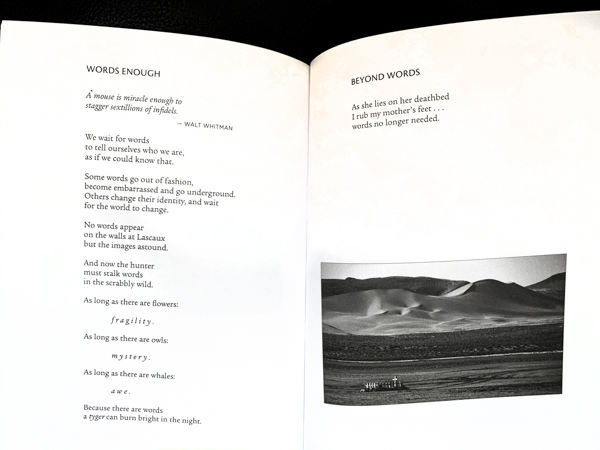
by successfulbob | art books, Guest Post, inspiration, photography, photography education
My photographer friend Sara Frances shared her trials and tribulations of self-publishing a photo book. This is part two of a five part series. Read on for some great ideas. (Editor) Start with Part One
Publishing Path Part Two
In this issue we’re tackling the conception of your book to the birth; the first three steps. Concept, audience and content. Most artists and photographers would incorrectly argue that their art is the first thing to be considered. At least not when a book is the concept.
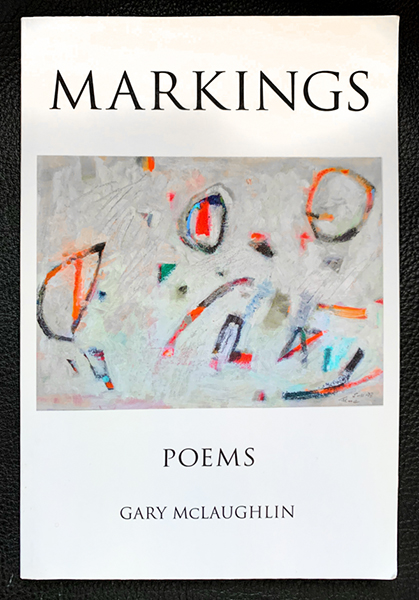
Gary McLaughlin and longtime friend Glory Ann Penington teamed up in a self-published Blurb printing, now to be reissued with a commercial printer to get serious about selling.
What is your concept?
Ask what you have to say as an art photographer. Your theme, favorite subject, particular style, longtime project—what you believe in as an artist, what moves your soul. This is not a portfolio; nothing like what we do every day for our clients and to attract new ones. To be viable, a photo book cannot be a loose collection, but must tell a cohesive story—the story you are simply itching to tell!

Yes these artists know each other well; fitting images to the words and vice versa is a powerful combination.
Define your audience
Then the next question is to define the audience for that specific story. The scope of potential audience determines quantity print run as well as whether a specific topic will gain traction. Call it market research, or just plain search, for salability. This means going to book stores, photo book stores, and internet. But that’s not all: gift stores, museums, art galleries that offer photography are the next rung of outlets where you book might find a welcoming audience. How about new age or inspirational stores, even hospital gift shops! How about non-profit schools or nature institutions (that’s called special sales)?
Control your sales
Do you want to capitalize on a current trend or do you want to strike out to fill a topic niche that you feel is under-represented? Here are three approaches for controlling costs and expanding audience.
• Since the documented sales of most limited edition art photo books is 80 copies or less, you may choose a very limited run that you are sure you can see to family and friends—say 50 copies. Many art and poetry book printers require a commitment of this quantity as a pre-condition. Not a wrong answer.
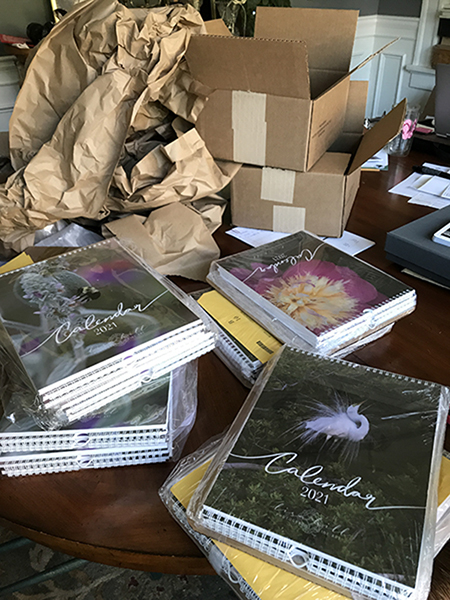
Master Photographer Lisa Hill teamed up with three non-profits she is passionate about to offer calendars of her art work, entirely for their benefit—and no up-front cost to her
• If you want to scale your potential sale numbers, the collaborative route will open doors. Team up with an author, and your mail list more than doubles: yours, the author’s, and people interested in hybrid works. Added value.
• Teaming with a special interest non-profit that is involved in the subject of your images has potential, assuming the product is something the charity’s public will get behind. Be prepared to provide significant percent of monetary return as well as doing a significant part of the marketing and all of the fulfillment.
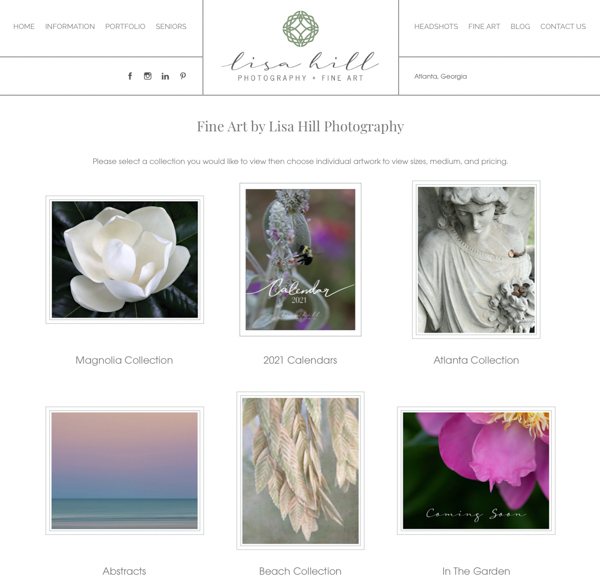
Lisa is a demon social media self promoter. Her line of art prints, calendars, cards and commercial work all feed off each other. Note her lovely logo and signature.
Sara Frances
 Sara is a many-decades Master Photographic Craftsman out of Denver whose artistic focus has always been book making with images. Her albums won PPA merits starting well before digital capture, as well as for what is believed to be the first ever awarded portrait album. She has evolved from daily, shorter-term studio photography into exclusively special projects of long commitment. Her second hybrid photo/memoir art book, Fragments of Spirit, now published under her own mark, Photo Mirage Books, is available mid-December 2020.
Sara is a many-decades Master Photographic Craftsman out of Denver whose artistic focus has always been book making with images. Her albums won PPA merits starting well before digital capture, as well as for what is believed to be the first ever awarded portrait album. She has evolved from daily, shorter-term studio photography into exclusively special projects of long commitment. Her second hybrid photo/memoir art book, Fragments of Spirit, now published under her own mark, Photo Mirage Books, is available mid-December 2020.
Renewing her lifelong interest in creative writing, she was recently was accepted for Lighthouse Writers Workshop’s Poetry Collective, graduating a year later with a forthcoming hybrid work marrying over 275 manipulated iPhone images with 120 poems: What to Wear to Paradise.
Her three-year quest to learn all facets of the art book industry has influenced her to give back with hands-on publishing classes. She is a judge for the Independent Book Publishers Association (IBPA) and for Colorado Independent Publishers Association (CIPA.) She teaches for Osher Lifelong Learning Institute (OLLI) at the University of Denver, for PPA Super One Day seminars, and also mentors hybrid image/text projects.
To find Sara on social media search SaraFrancesPhotographer or email – imagination@photomirage.com
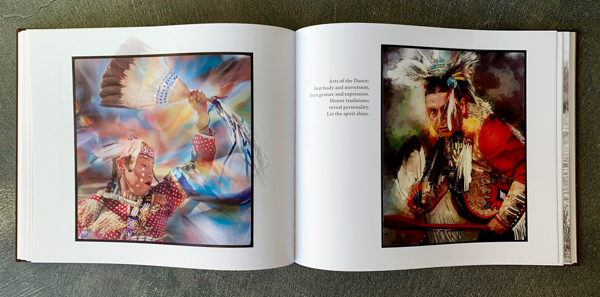
by successfulbob | art books, Guest Post, inspiration, marketing, photography education, photography marketing, success education
Fellow photographer Sara Francis has published photo books and asked to share the trials and tribulations of getting them into print. Please welcome Sara with these guest posts as she shares this five-part series on getting a photo book into print.
Your Photographic Forever; a five-part series that will make you want to put your images into print. Why Print a photo book now?
In spite of distancing and upheaval, it’s a great time to publish a photo book—your photographic art in book form. My personal experience on the road to publish my retrospective and photo-memoir kickstarts this series. Here’s the good news.
All book sales, including art and photo books, are up more than 100%. As photographers, we already own and work with many of the tools needed to conceive and design an attractive, salable book—without paying for costly designers and editors. Printing costs are now much less than you’d expect.
The concept of a book, a stunning, coffee table book, hard cover, with a wide-ranging folio of our own work, well, that’s a goal that most of us have fostered for some time. I tried all sorts of avenues, including university presses for my 60-year photo project and memoir of the Taos Native American Pueblo, the artists of Taos I have known and the wonder of the region. Yes, strong regional interest and potential audience. I discovered four major roadblocks.
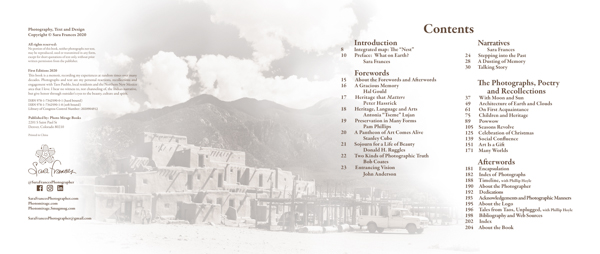
A great title, and also an informative, attractive contents page must grab attention. Note that most books are filed with only the spine showing, so be sure to have title, author and publisher name or mark showing.
Choose your publisher
Institutional presses, if they accept you at all, take at least two years to come to print, and you have little say in the design and presentation. Exclusively photo and art book printers have limited funds and take a handful of projects a year. Many say they approach only photographers they themselves name. No chance to submit. More mainstream publishers are so genre-conscious that images, especially images with text or poetry are simply not a fit they consider. Worse, publishers who claim support for new or regional artists mostly just want to sell you their design and editing services, so you still have little input.
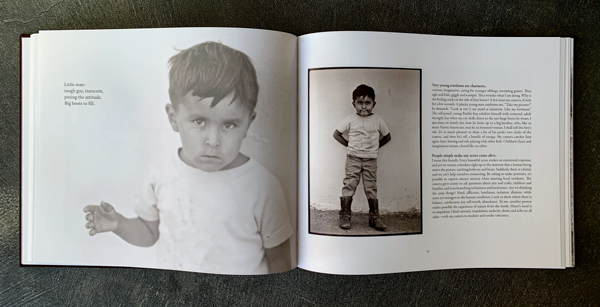
Image and text, both poetry and memoir, tell the story of why I photographed this child.
This the bad news I encountered, and it was a deal breaker. I’ve spent more than three years figuring out how to do it myself, my way. I set out to work through the entire process from concept to design to print to distribute and promote. I wanted my book to look just like I wanted, not someone else’s design. At this point I can give you more good news. Over 50% of all books published are now independently or self published. And this trend continues to increase.

Ceremonial color proves a good foil for the sepia duo-tones in telling the regional story.
Steps forward
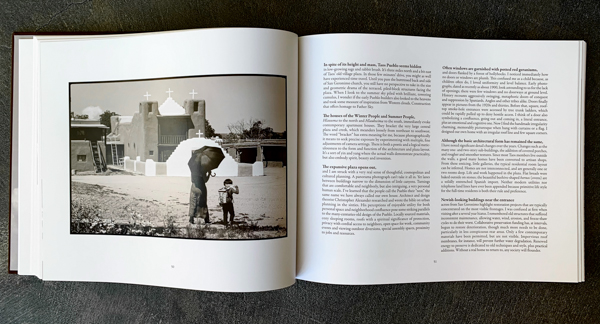
Classic rule of thirds composition in a grab shot, again unfolds the story.
Here’s the breakdown of steps to make the process financially feasible and technically manageable. In this series I hope I can coach you to think seriously about publishing and start the process toward reward under you own hand.
Concept
Audience
Content
Printer choice
Design
Edit
Warehouse
Distribution
Promotion
Bob is the first one to tell you that you don’t get rich on a book. My job is to show you steps to publish that won’t break the bank. And the riches! The satisfaction of a beautiful book is worth everything.
Proceed to Part Two of your book publishing path.
Sara Frances
 Sara is a many-decades Master Photographic Craftsman out of Denver whose artistic focus has always been book making with images. Her albums won PPA merits starting well before digital capture, as well as for what is believed to be the first ever awarded portrait album. She has evolved from daily, shorter-term studio photography into exclusively special projects of long commitment. Her second hybrid photo/memoir art book, Fragments of Spirit, now published under her own mark, Photo Mirage Books, is available mid-December 2020.
Sara is a many-decades Master Photographic Craftsman out of Denver whose artistic focus has always been book making with images. Her albums won PPA merits starting well before digital capture, as well as for what is believed to be the first ever awarded portrait album. She has evolved from daily, shorter-term studio photography into exclusively special projects of long commitment. Her second hybrid photo/memoir art book, Fragments of Spirit, now published under her own mark, Photo Mirage Books, is available mid-December 2020.
Renewing her lifelong interest in creative writing, she was recently was accepted for Lighthouse Writers Workshop’s Poetry Collective, graduating a year later with a forthcoming hybrid work marrying over 275 manipulated iPhone images with 120 poems: What to Wear to Paradise.
Her three-year quest to learn all facets of the art book industry has influenced her to give back with hands-on publishing classes. She is a judge for the Independent Book Publishers Association (IBPA) and for Colorado Independent Publishers Association (CIPA.) She teaches for Osher Lifelong Learning Institute (OLLI) at the University of Denver, for PPA Super One Day seminars, and also mentors hybrid image/text projects.
To find Sara on social media search SaraFrancesPhotographer or email – imagination@photomirage.com

by successfulbob | Guest Post, Marketing Monday, photography, photography education, photography marketing
Portrait Pricing Guidelines with Steve Bedell – Part Four
Marketing Monday Guest Post
Here is Steve’s continuation from part 1 and part 2 and part 3 portrait pricing
“Six: Wall portrait bonus
We all know the money is in the wall portraits and wall groupings. So from our initial contact right through the sales session that’s what we should be striving for. To drive that point home, I offer a discounted price of about 30% off on gift prints when they purchase a portrait 20 inches or larger. (Note: The discounted price is the price I feel I should sell that product for. If they don’t have a wall portrait I am just more profitable on the smaller prints)
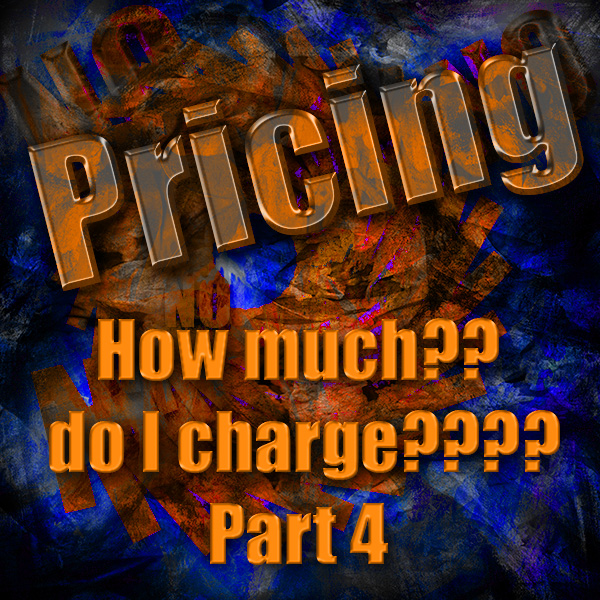
SEVEN: Albums
I know many photographers like albums. I am not a huge fan. You either have to take the time to do the layout or pay someone to do it (my choice). I know you can get big numbers from them but make sure you cover all your bases, including time, when deciding the pricing.
I prefer Album boxes. Make a few 5×7’s for peanuts, slide into 8×10 mats and put into the box. Pretty simple plus if you make an error in any image you just change out one print.
EIGHT: ALWAYS list most expensive product first
I’m firm on this one; this is pretty much an unbreakable rule. People read from the top down, left to right. Start out with that 40×60 for half a million bucks (you wish) and by the time they get down to that 16×20 for $800 it’s going to look pretty inexpensive. The mind works this way, at first they think ‘Oh my God, I can’t afford this’ to ‘Well, that’s more in my budget’. Start small to large and it’s an uphill battle.
It works the same way with your good/better/best pricing, always list the most expensive product first or right to left.
NINE: Session fees
OK, there’s a lot of wiggle room in this one. I know some VERY successful (Bradford) photographers who have no session fees. I know others who have very high session fees. Which is better for you?
Well, Bradford has a brilliant system where he has one background and I’d guess not much changing in the lighting. In my semi-retirement, I am doing everything from the consultation to the shoot to print delivery on location. That’s a significant chunk of time to be doing everything for free so I have a session fee of $300. That works for me, you may be different.
But there is another good reason to have that session fee. You don’t want to discount your products but the session fee can be used as a bargaining chip. You can do 50% off session fee promotions, free sessions for returning/good clients, etc. and not be hurting your sales average.
TEN: Payments
When we tally up the order we ask ‘How would you like to pay for that’. Most people either give you a check or a credit card and that’s the end of it. If they ask if they have to pay it all up front, we tell them they can pay 50% now, the balance when they pick up. 90% pay in full right off. I don’t offer payment plans, that’s what credit cards are for.
ELEVEN: Minimum orders
I’ve never had minimum orders. Why? I feel like they act as a barrier. Job one is to get people in front of your camera. People may not like the idea of having to spend a certain amount of money before even seeing the end result.
Have I ever been burned on this? Of course, but not that often. We are very comfortable with our photography and sales skills so we’ll put that risk on us.
TWELVE: Wall Groupings
You sell wall groupings by showing wall groupings. That is one of the big benefits of Proselect, Swift Galleries and others. Most can even let you show them on their own walls. If you go to the house during or before the shoot, you can take pics of the walls ahead of time. You can also ask them to do, some will, some won’t.
I price my wall groupings at a slight discount to buying the images individually. Why? I’d rather sell 3-5 images than just one. Most of the wall groupings I sell are Gallery Wraps.
Big tip: Use the templates from your lab. ACI has over 25 different templates and when you order them as a grouping the price is about 15% less than if you ordered them individually. Design your wall groupings ahead of time using these templates and you’ll be even more profitable.
THIRTEEN: Don’t use dollar signs or odd number pricing.
If you’re a low end studio, go ahead and price your work using dollar signs and odd number pricing. Example: 8×10 for $34.95. If you are trying to convey that you are a luxury product, use 20×24 for 1100. An Hermes bag is not priced at $4997, it is priced at 5000.
”
Steve Bedell has been a professional photographer for over 35 years. He has done weddings, portrait and commercial work but now restricts his business to portraits only.
Steve holds the Master of Photography and Photographic Craftsman degrees from the Professional Photographers of America and is a PPA Approved Print Juror.
commercial work but now restricts his business to portraits only.
Steve holds the Master of Photography and Photographic Craftsman degrees from the Professional Photographers of America and is a PPA Approved Print Juror.
He has been named the New Hampshire Photographer of the Year a record 8 times and in 2011 was awarded the New England Photographer of the Year title. His specialty is natural light portraiture.
He has written hundreds of articles for photo publications, taught classes and workshops nationwide and produced several lighting DVDs. His private newsletter, EPhoto, reaches over 2000 photographers. Steve was a regular contributor to Shutterbug magazine.
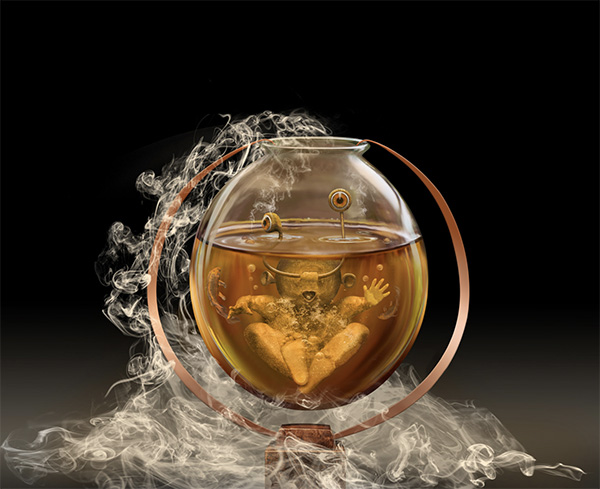
by successfulbob | fine art photography, inspiration, photography, photography education
Imaging USA 2019 – Atlanta, GA Part Two
Find Part 1 here
I mentioned networking in my last post as a reason for attending Professional Photographers of America’s Imaging USA. Let me add that it is a great time to recognize the achievements of your fellow photographers.
American Society of Photographers – Fellowship
One of these events is the American Society of Photographers Banquet. There is more networking, of course, but so much more. ASP has worked very hard over the past couple years to become more inclusive and make the awards banquet something to really look forward to. There were two new ASP Fellows Ella Carlson and Kristi Elias. While their images and papers have not been posted as yet on the ASP site you can get an idea by checking out other ASP Fellow papers (ASP Fellows)
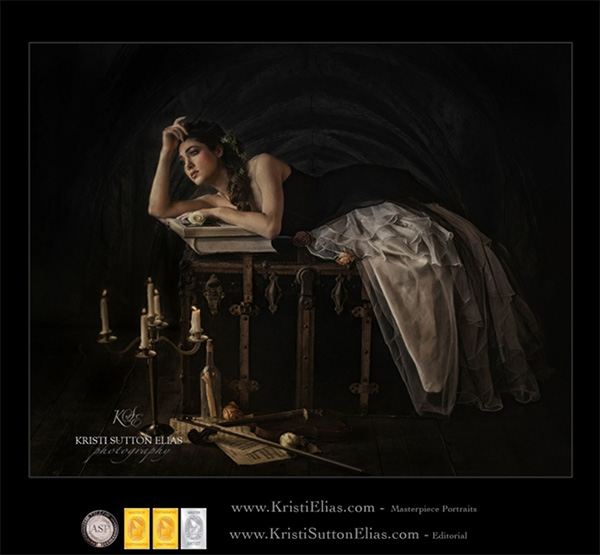 One of twenty-five images submitted by Kristi for the Fellowship. See the rest of her images and read her paper for more of her fascinating photographic journey! Image © Kristi Elias – 2019 All Rights Reserved.
One of twenty-five images submitted by Kristi for the Fellowship. See the rest of her images and read her paper for more of her fascinating photographic journey! Image © Kristi Elias – 2019 All Rights Reserved.
 Here’s a link into Ella’s exquisite world of Aliens used in attaining her Fellowship.
Here’s a link into Ella’s exquisite world of Aliens used in attaining her Fellowship.
Image © Ella Carlson 2019 All Rights Reserved.
Eligibility to apply for the ASP Fellowship requires that an individual hold at least one of the PPA Master degrees, be a current ASP member in good standing, AND have acquired 15 additional print merits AFTER receiving their degree during contiguous years of ASP membership.
The applicant must complete a minimum of three consecutive years membership in ASP prior to application. A thesis/personal paper of at least 2000 words providing insight into their photographic or artistic journey, influences, philosophies and passion that make them the photographer or artist they are today.
The applicant must also submit a portfolio of 25 exquisite images characteristic of his or her finest work that is a visual representation of their written paper.
Recipients of the Fellowship must maintain membership in ASP and PPA.
American Society of Photographers – Educational Associate
Steve Clark earned his Education Associate. (read Steve’s paper here) The ASP Educational Associate is conferred on those special individuals who actively participate and promote the ideals and philosophies of the organization beyond the initial recognition given with their acceptance into the Society. It is available to all active, life, honorary life and international members of the Society that hold a PPA Craftsman degree.
The ASP Educational Associate requires that an individual hold the PPA Photographic Craftsman degree, be a current ASP member in good standing, AND have acquired 30 additional speaking, teaching, or writing merits AFTER receiving their degree during contiguous years of ASP membership.
The applicant must write a paper of at least 4000 words of individual research and thought that demonstrates the applicant’s mastery of the field and supports a position for a new idea, development or trend. (read other ASP Associate papers here)
Hmmm. This post has gone on for a while guess I’ll be adding a part three to these Imaging USA posts.
Yours in creative Photography, Bob
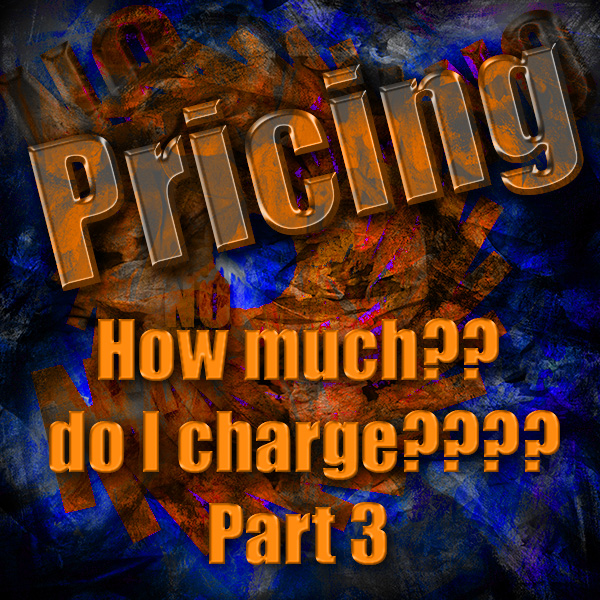
by successfulbob | Guest Post, Marketing Monday, photography, success education
Portrait Pricing Guidelines with Steve Bedell – Part Three
Steve Bedell shares his thoughts on Portrait Pricing.
“As I reviewed my part 1 and part 2 of this pricing topic here on Successful-Photographer I was astounded that having so much knowledge I wasn’t worth about 27 million dollars! In any case, there was great response to the article about pricing in general and how to determine where you should be in it so now we continue with specifics.
Please note that much of this is my opinion but a great deal of it is what I’ve learned by PSTM (people smarter than me) so I stray from these guidelines at your own risk. With that in mind, let’s get going. Again, my mind kinda wanders all over the place so things may not be in proper order, but put up with me, the info is the same.
 ONE: Should I have a printed price list?
OK, I’m not kidding here. I see in online groups people asking for all kinds of feedback on their price list. NOT the pricing, but how the price list looks. They’ll discuss fonts, layout, etc. They’ll look nice and pretty but does it really matter? We’ll come back to that but question two is related so let’s get to that right now.
ONE: Should I have a printed price list?
OK, I’m not kidding here. I see in online groups people asking for all kinds of feedback on their price list. NOT the pricing, but how the price list looks. They’ll discuss fonts, layout, etc. They’ll look nice and pretty but does it really matter? We’ll come back to that but question two is related so let’s get to that right now.
TWO: Should I post prices online?
This one is MUCH easier to answer: NO!
Why? Because if someone goes online looking for a photographer and does a Google search and they see your 8×10 (the standard that they all know) is $195 and Joe’sSuckyPhotos.com is $29, which one will they choose? They’ll most likely choose Joe because they are just looking at prices and when you compare pricing in a vacuum you are looking at a commodity. If they visit your site and instead see your special booklet that tells them ‘5 Tips for a Great Family Portrait’ and lots of testimonials you have already set yourself apart from the bottom feeders.
OK, so now that we have a little background, should you have a printed price list?
I say yes, so it doesn’t look like you’re just pulling prices out of the air. But do you need to print up hundreds and send/email them to everyone who contacts you?
No.
You only really need one, and that’s for you to use in the sales room. Don’t believe me? Bradford Rowley uses a SLIDE of the price list during the sales session and only leaves it there for as short as possible. You want people focused on picking the best pose and the proper size portrait, you do NOT want them sitting there with their nose in a price list.
A little caveat here. I am talking about a PRICE LIST, not a Product Guide. A product guide will show sample of the products and a starting price or price range. One of the best I’ve seen is by Megan Dipiero. We featured Megan a little while ago, you can see her guide HYPERLINK “http://files.megandipiero.com/product-guide/?page=1” \t “_blank” here.
THREE: When should I show the price list?
There are different schools of thought on this.
Some say don’t ever show it, just let them come to the order appointment, write up what they want, then tell them the price.
Others tell them pricing during the consultation when the session is booked.
I’ve used both methods, they both work. I prefer the up front method, it makes me and them more comfortable at the sales session, less like I’m holding the images hostage. Do what you’re comfortable with and what works for you. Previous to a consultation, always use a price range instead of exact pricing, like ‘Our gift prints start at $95 and wall collections begin at $1800’ or something along those lines. They’ll have a better idea of why you charge what you do during the consultation.
FOUR: Good/Better/Best pricing
This model has been around since the dinosaurs. Why? Because it works! I have my ‘paper prints at level 1, canvas prints at 2, and Gallery Wraps and metals at level 3. Decide size first, then finish. This gives you an opportunity to make more income on the same sized print. As an example, my 16×20’s are $600/$750/$925. This may seem very low to some and high to others. Also, don’t just call them finish one, two, three. Use names like The Masters, The Venetian, etc and include a descriptive paragraph like ‘enhanced by our artist and bonded to natural fiber canvas’.
FIVE: Should I have a contract?
I read many posts where photographers sound like wannabe lawyers. I like to concentrate on the experience so introducing a contract into the mix just doesn’t work for me. You should have policies for payment but in 40 years of doing this I’ve had no need for a contract. Weddings, yes, portraits, no. It’s up to you.”
More to come as Steve brings the rest of this home in Part 4 on Successful-Photographer.
Steve Bedell has been a professional photographer for over 35 years. He has done weddings, portrait and commercial work but now restricts his business to portraits only.
Steve holds the Master of Photography and Photographic Craftsman degrees from the Professional Photographers of America and is a PPA Approved Print Juror.
commercial work but now restricts his business to portraits only.
Steve holds the Master of Photography and Photographic Craftsman degrees from the Professional Photographers of America and is a PPA Approved Print Juror.
He has been named the New Hampshire Photographer of the Year a record 8 times and in 2011 was awarded the New England Photographer of the Year title. His specialty is natural light portraiture.
He has written hundreds of articles for photo publications, taught classes and workshops nationwide and produced several lighting DVDs. His private newsletter, EPhoto, reaches over 2000 photographers. Steve was a regular contributor to Shutterbug magazine.





 Sara is a many-decades Master Photographic Craftsman out of Denver whose artistic focus has always been book making with images. Her albums won PPA merits starting well before digital capture, as well as for what is believed to be the first ever awarded portrait album. She has evolved from daily, shorter-term studio photography into exclusively special projects of long commitment. Her second hybrid photo/memoir art book, Fragments of Spirit, now published under her own mark, Photo Mirage Books, is available mid-December 2020.
Sara is a many-decades Master Photographic Craftsman out of Denver whose artistic focus has always been book making with images. Her albums won PPA merits starting well before digital capture, as well as for what is believed to be the first ever awarded portrait album. She has evolved from daily, shorter-term studio photography into exclusively special projects of long commitment. Her second hybrid photo/memoir art book, Fragments of Spirit, now published under her own mark, Photo Mirage Books, is available mid-December 2020.
















